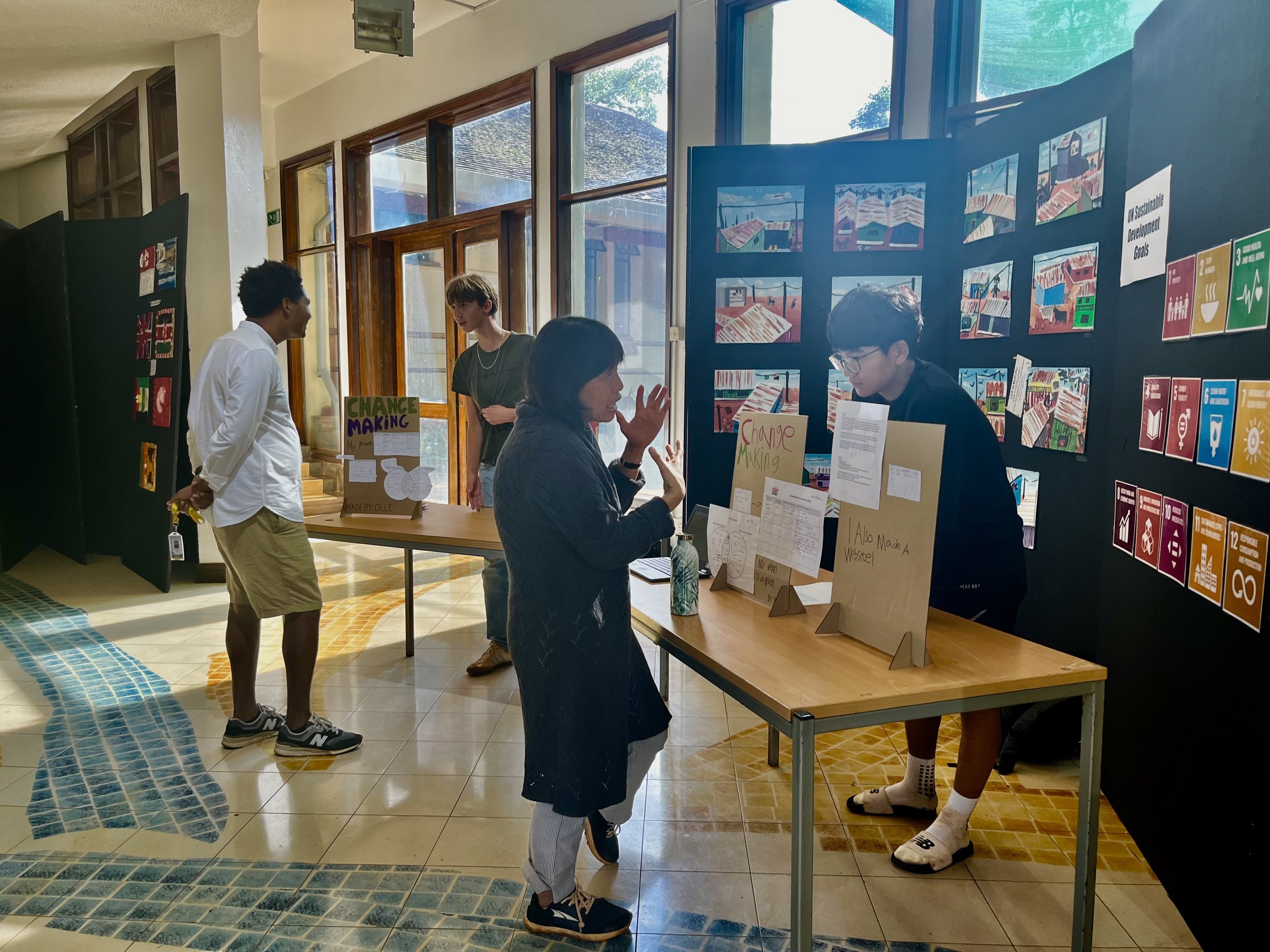Building changemakers and changeseekers through a coaching partnership
Grade 7 students sharing their learning and modelling advocacy at a Changemaker Fair, the summative assessment and reflection for a “Becoming a Changemaker” unit at the International School of Kenya.
by Brian Lavender, Storyteller
At the International School of Kenya (ISK), middle school ELL (English Language Learners) educator Susan Cizek has redefined what it means for her students to be “changemakers” thanks to a transformative coaching partnership with LeeAnne Lavender. This collaboration led to a dynamic reimagining of Susan’s “Becoming a Changemaker” unit, adding real-world action, community engagement, and a new layer of advocacy.
A New Approach to Teaching Changemaking and Changeseeking
Previously, the unit focused on exploring historical heroes, but Susan and LeeAnne saw the potential for innovation. Susan describes the change: “I took a unit on heroes and merged it with project-based learning, where students could self-select their focus. LeeAnne helped with creating a new outcome, resulting in a final gallery walk that focused on public speaking and sharing advocacy with the community.”
This new, action-oriented unit culminated in the Changemaker Fair, an advocacy event where students presented their projects to peers, teachers, and community members. “Putting students in front of others gave them a real, live experience of sharing their growth,” Susan explains, highlighting the empowerment her students felt by presenting their ideas publicly.
Below: students create planning documents to synthesize learning and prepare for the Changemaker Fair.
Embracing the Term "Changeseeker"
A significant shift in the unit was LeeAnne’s introduction of the term “changeseeker.” Susan shared that “changemaker” suggests direct action, but “changeseeker” allows for a broader understanding. She elaborates, “The term opened up the idea that you don’t have to ‘go out and do something’; you can advocate by writing a letter to the UN, making a poster, or just talking to others.” For students, especially in an ELL class, this idea of advocacy through learning and sharing made taking action more accessible and personalized.
Bringing in Community and Global Perspectives
LeeAnne’s coaching extended beyond vocabulary. She also supported Susan with locating local changemakers through the school’s CAS coordinator, including a guest from Amnesty International, who offered a powerful message on the importance of individual action. “He encouraged my students to take even small actions, like sharing issues with friends or family, as a step toward change,” Susan recalls. This interaction also allowed students to practice interviewing skills, sparking discussions on the nuances of advocacy.
In another creative approach to connecting personal interests with global issues, LeeAnne introduced a Venn diagram activity that helped students explore the question: “What’s your why?” Students mapped their skills on one side and global issues on the other, with the intersection representing their unique potential to make a difference. One memorable story Susan shared as an example was of a 100-year-old Australian man who knitted sweaters for penguins affected by an oil spill. The example inspired students to think creatively about how they could contribute to causes they care about.
In support of this challenge, LeeAnne was highly intentional in creating a series of videos that Susan could use with students to introduce key ideas and concepts. Here’s an example of a video about the language of changemaking and changeseeking, and please feel free to use it with your students if it’s helpful, too.
A Lasting Impact
Susan credits the partnership with not only enhancing her teaching approach but also creating an environment of excitement and support. “Having a thinking partner like LeeAnne was crucial,” she explains. “As the only ELL teacher, it’s easy to feel siloed. Working with her made me feel supported and energized to bring this unit to life.”
The impact went beyond the unit itself. “We brought in Kenyan artists and had ninth and tenth-grade ELL students participate as well. Families came in, and everyone saw how interconnected our work was,” Susan notes. “It created a beautiful end-of-year event that connected students across grades and even into the community.”
In addition, the redesign of this grade 7 unit is deeply rooted in the school mission/vision and educational aims. There are five aims for all students at ISK and these are called “The Big Five” (which is a wonderful tip of the hat to the Big Five animals of Africa and the context of where ISK is located geographically and culturally). Of the Big Five, “changemaker” is overtly aligned with this unit, but all other aims (self-manager, thinker, collaborator, and communicator) are embedded into everyday teaching and learning, and assessment.
When teachers use a service learning/community engagement model to design curriculum, the applied and hands-on aspects of learning inevitably support these types of foundational, guiding principles in international schools.
Below: a snapshot of the ISK Big Five educational aims.
Looking Forward
Susan sees potential to build on this success, including more connections with the broader community: “I’m already exploring ways to invite guest speakers for my seventh graders in the next semester. I hope to create more cultural connections that allow students to learn and contribute meaningfully.”
Susan also plans to integrate additional storytelling elements around Earth Day and other school events.
Through their work together, Susan and LeeAnne have shown that changemaking and changeseeking is about more than direct action—it’s also about self-awareness, empathy, and inspiring students to be advocates for change. With the Changemaker Fair as a cornerstone of this approach, ISK’s MS ELL students are learning that they have the power to create meaningful change, one step at a time.
Below: LeeAnne and Susan on a coaching call.
LeeAnne partners with educators and teaching teams as a coach to redesign units and assessments. Typically, a coaching partnership involves three or four meetings via Zoom, and email correspondence back and forth before, during and after the unit. Please contact LeeAnne if you’d like to redesign a unit and create ways for your students to apply their knowledge and skills in authentic local and global contexts.





